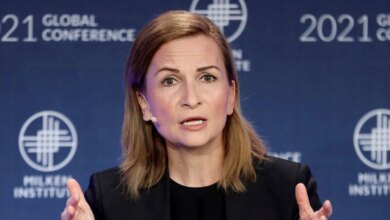U.S. consumer confidence rebounds; house price growth likely peaked

Buyers browse in a grocery store whereas sporting masks to assist gradual the unfold of coronavirus illness (COVID-19) in north St. Louis, Missouri, U.S. April 4, 2020. REUTERS/Lawrence Bryant
WASHINGTON, Oct 26 (Reuters) – U.S. client confidence unexpectedly rose in October as considerations about excessive inflation had been offset by enhancing labor market prospects, suggesting financial progress was choosing up after a turbulent third quarter.
The survey from the Convention Board on Tuesday confirmed customers keen to purchase a house and big-ticket objects similar to motor autos and main family home equipment over the subsequent six months. The share of People planning to go on trip was the biggest since February 2020, simply earlier than the nation was slammed by the primary wave of COVID-19 infections.
A resurgence in coronavirus circumstances over the summer season, pushed by the Delta variant, and supply-chain constraints associated to the pandemic restrained financial exercise final quarter.
“Customers are extra upbeat after a rocky third quarter and this argues for a powerful end for the economic system in 2021,” mentioned Christopher Rupkey, chief economist at FWDBONDS in New York. “Customers know the tight labor market has their backs. These forecasting a recession from the drop within the confidence late in the summertime should again off that decision.”
The patron confidence index elevated to a studying of 113.8 this month from 109.8 in September, ending three straight month-to-month declines. The measure, which locations extra emphasis on the labor market, stays under its peak of 128.9 in June. The rise contrasted with the College of Michigan’s survey of customers, which confirmed sentiment falling early this month.
The rebound in confidence coincided with an ebb in coronavirus infections. Customers had been upbeat about each present situations and the short-term outlook. Economists polled by Reuters had forecast that the index would dip to 108.3.
The Convention Board’s so-called labor market differential, derived from information on respondents’ views on whether or not jobs are plentiful or exhausting to get, raced to a studying of 45 this month, the very best in 21 years, from 43.5 in September.
This measure intently correlates to the unemployment price within the Labor Division’s intently watched employment report.
Mixed with declining new claims for unemployment advantages, it raises hopes that job beneficial properties picked up this month after employers employed the fewest employees in 9 months in September. Slower job progress has been blamed on pandemic-related labor shortages. There have been 10.4 million job openings on the finish of August.
“That is one other signal that job progress reaccelerated in October,” mentioned Ryan Candy, a senior economist at Moody’s Analytics in West Chester, Pennsylvania.”It factors towards a decline within the unemployment price in October.”
Shares on Wall Avenue had been buying and selling largely larger. The greenback rose in opposition to a basket of currencies. U.S. Treasury costs had been blended.
HITTING THE ROAD
Customers’ inflation expectations over the subsequent 12 months jumped to 7.0%, the very best in 13 years, from 6.5% final month.
Regardless of perceptions of excessive inflation, customers deliberate to step up spending. Shopping for intentions for motor autos rebounded from a nine-month low. Extra customers supposed to buy family home equipment like washing machines, tv units and fridges over the subsequent six months.
Some economists speculated that larger costs had been forcing customers to convey ahead purchases to keep away from paying much more for items. The rebound recommended client spending would regain steam after an obvious sharp deceleration final quarter.
Economists consider the federal government’s snapshot of third-quarter gross home product progress on Thursday will seemingly present that client spending stalled final quarter after rising at a strong 12% annualized price within the April-June interval.
With spending weak, third-quarter GDP progress estimates are largely under a 3% price. The economic system grew at a 6.7% tempo within the second quarter. The anticipated slowdown would mirror widespread shortages, together with for items similar to motor autos and a few family home equipment, in addition to the Delta variant’s hit to spending on companies like air journey and lodge lodging.
“Slower progress does not indicate a weak economic system,” mentioned Joel Naroff, chief economist at Naroff Economics in Holland, Pennsylvania. “There’s nothing delicate about it, no less than in the case of demand.”
Client spending this quarter can also be prone to be boosted by elevated demand for journey. The share of customers saying they plan to take a trip within the subsequent six months elevated to 47.6%. That was the very best determine for the reason that pandemic began and was up from 42.3% in September.
They largely deliberate journeys in america and supposed to both drive or fly to their locations.
There was excellent news on the housing market. In a separate report on Tuesday, the Commerce Division mentioned gross sales of latest single-family houses surged 14.0% to a seasonally adjusted annual price of 800,000 models in September.
The Convention Board survey confirmed customers extra inclined to purchasing a house over the subsequent six months. The housing market may get a carry from a moderation in home value inflation.
A 3rd report on Tuesday confirmed the S&P CoreLogic Case-Shiller’s 20 metropolitan space dwelling value index rose 19.7% on a year-on-year foundation after a report 20% leap in July.
Indicators that home value progress has peaked had been evident in a fourth report from the Federal Housing Finance Company that confirmed home costs rose 18.5% within the 12 months by way of August after surging by a report 19.2% in July.
“The slowing acceleration in dwelling costs means that purchaser fatigue is setting in, notably amongst higher-priced houses the place the acceleration in value progress from the earlier month has been bigger in comparison with low-tier houses,” mentioned Selma Hepp, deputy chief economist at CoreLogic.
Reporting by Lucia Mutikani
Enhancing by Chizu Nomiyama and Paul Simao
:





